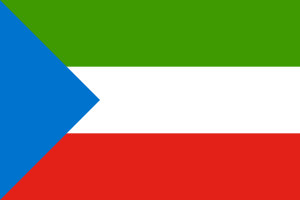1968 Equatorial Guinea constitution facts for kids
Quick facts for kids Constitution of Equatorial Guinea of 1968 |
|
|---|---|

First flag of the Equatorial Guinea
|
|
| Jurisdiction | Republic of Equatorial Guinea |
| Created | 17 April 1968 |
| Ratified | 11 August 1968 |
| Date effective | 12 October 1968 |
| System | Unitary presidential republic |
| Repealed | 29 July 1973 |
The Constitution of Equatorial Guinea of 1968 was the first set of main rules for the country. It was created when Equatorial Guinea was about to become independent on October 12, 1968. This important document set up a system where people had many freedoms. It supported things like liberal democracy, which means people have a say in their government. It also believed in popular sovereignty, meaning the power comes from the people. The constitution also protected freedom of religion and the right for people to decide their own future. This was happening even when Spain, which used to rule Equatorial Guinea, was under a different kind of government led by Francisco Franco.
This constitution said that Equatorial Guinea would be a free, united, and democratic country. It would have a president chosen by all citizens in a secret vote every five years. The constitution also made sure that people's basic rights and freedoms were protected. It organized the government into three main parts: one that makes laws (legislative), one that carries them out (executive), and one that makes sure laws are fair (judicial).
Contents
Making the 1968 Constitution
In December 1966, the Spanish government decided to start preparing for a new constitution. A special meeting, called the Constitutional Conference, began on October 30, 1967. After many discussions, the constitution was finished. It was then published on July 24, 1968.
To make it official, people in Equatorial Guinea voted on it in a special election on August 11, 1968. Teams from the United Nations watched to make sure the vote was fair. Most people, about 64% of those who voted, said "yes" to the new constitution. This constitution planned for a government with a main assembly (like a parliament) and a top court.
What Happened After the Constitution
The 1968 Constitution was officially in use for about four years, until July 1973. However, it didn't really work as planned for very long. This was because Francisco Macías Nguema became the leader when the country became independent.
In March 1969, during a difficult time with Spain, Macías Nguema said there was a plan to overthrow the government. He used this chance to remove people who disagreed with him. Then, in May 1971, he changed parts of the constitution. He did this to make his own power stronger and to create a government where only one political group was allowed. He said that Spain was trying to cause trouble. He also claimed that the constitution, even though he helped make it, was "made by Spain." In July 1972, he made another law that declared himself president for life. This meant he would be president forever.
What Was Inside the Constitution
The 1968 Constitution had a main introduction and ten main sections. These sections had 58 articles, which are like specific rules or laws. It also had some final rules about how it would start. Here's how it was organized:
- Preamble (an introduction explaining its purpose)
- Title I: The State and the Citizens (Articles 1 to 8)
- Title II: The Head of State (Articles 9 to 15)
- Title III: The Assembly of the Republic (Articles 16 to 33)
- Title IV: How the Government and Assembly Work Together (Articles 34 to 40)
- Title V: The Council of the Republic (Articles 41 and 42)
- Title VI: What the State and Provinces Can Do (Articles 43 and 44)
- Title VII: The Provinces and Cities (Articles 45 to 49)
- Title VIII: How Justice Is Administered (Articles 50 to 53)
- Title IX: International Relations (Articles 54 to 57)
- Title X: How to Change the Constitution (Article 58)
- Transitory Provisions (rules for the changeover period)
- Supplementary Provision (an extra rule, which said the people had to vote on the constitution)
See also
 In Spanish: Constitución de Guinea Ecuatorial de 1968 para niños
In Spanish: Constitución de Guinea Ecuatorial de 1968 para niños

